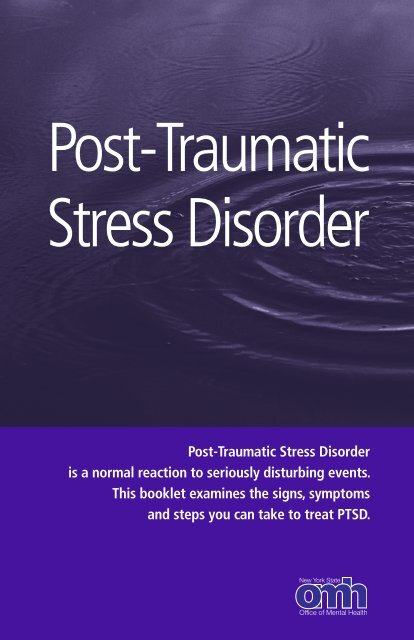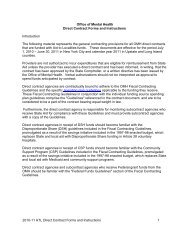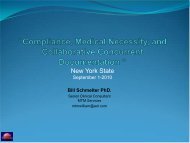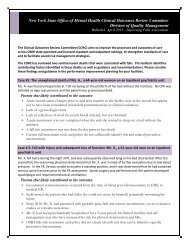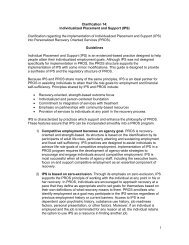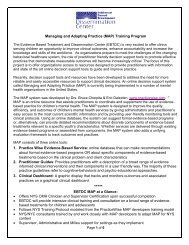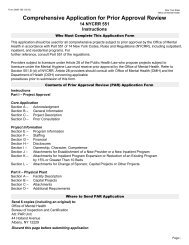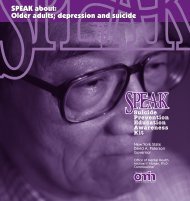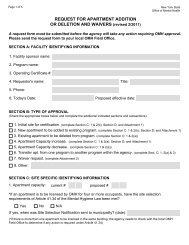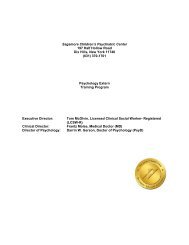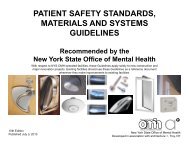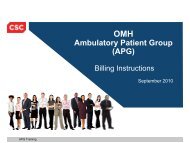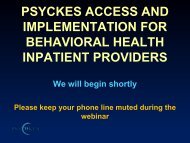Post-Traumatic Stress Disorder - Office of Mental Health - New York ...
Post-Traumatic Stress Disorder - Office of Mental Health - New York ...
Post-Traumatic Stress Disorder - Office of Mental Health - New York ...
You also want an ePaper? Increase the reach of your titles
YUMPU automatically turns print PDFs into web optimized ePapers that Google loves.
<strong>Post</strong>-<strong>Traumatic</strong><br />
<strong>Stress</strong> <strong>Disorder</strong><br />
<strong>Post</strong>-<strong>Traumatic</strong> <strong>Stress</strong> <strong>Disorder</strong><br />
is a normal reaction to seriously disturbing events.<br />
This booklet examines the signs, symptoms<br />
and steps you can take to treat PTSD.
Have you lived through a scary<br />
or dangerous event? Please put a check<br />
in the box next to any statements that sound<br />
like you.<br />
❑ Sometimes, all <strong>of</strong> a sudden, I feel like the event is happening<br />
over again. I never know when this will occur.<br />
❑ I have nightmares and bad memories <strong>of</strong> the terrifying event.<br />
❑ I stay away from places that remind me <strong>of</strong> the event.<br />
❑ I jump and feel very upset when something happens <br />
without warning. I feel like I’m constantly on guard.<br />
❑ I have a hard time trusting or feeling close to other people.<br />
❑ I sometimes feel emotionally numb.<br />
❑ I get mad very easily.<br />
❑ I feel guilty because others died and I lived.<br />
❑ I have trouble sleeping and my muscles are tense.<br />
PTSD is a real illness that needs to be treated.<br />
Many people who have been through <br />
a frightening experience have this illness.<br />
It’s not your fault and you don’t have to suffer.<br />
Read this booklet and learn how to get help.<br />
You can feel better and get your life back!
<strong>Post</strong>-<strong>Traumatic</strong> <strong>Stress</strong> <strong>Disorder</strong><br />
What is <strong>Post</strong>-<strong>Traumatic</strong> <strong>Stress</strong> <strong>Disorder</strong> (PTSD)?<br />
PTSD is a real illness. People may get PTSD after living through a disturbing<br />
or frightening experience. It can be treated with medicine and therapy.<br />
You can get PTSD after you have been:<br />
•Raped or sexually abused<br />
•A victim <strong>of</strong> emotional or physical abuse by someone in your family<br />
•A victim <strong>of</strong> a violent crime<br />
•In an airplane or car crash<br />
•In a hurricane, tornado, or fire<br />
•In a war<br />
•In an event where you thought you might be killed, or<br />
•After you have seen any <strong>of</strong> these events<br />
If you have PTSD, you <strong>of</strong>ten have nightmares or scary thoughts about the<br />
experience you went through.You try to stay away from anything that reminds<br />
you <strong>of</strong> your experience.<br />
You may feel angry and unable to trust or care about other people.You may<br />
always be on the lookout for danger.You can feel very upset when something<br />
happens suddenly or without warning.<br />
When does PTSD start and how long does it last?<br />
For most people, PTSD starts within three months <strong>of</strong> the event. For some<br />
people, signs <strong>of</strong> PTSD don’t show up until years later. PTSD can happen to<br />
anyone at any age. Even children can have it.<br />
Some people get better within six months, while others may have the illness<br />
for much longer.<br />
Am I the only person with this illness?<br />
No.You are not alone. In any year, 5.2 million Americans have PTSD.<br />
Women are more than two and a half times as likely as men to develop<br />
PTSD. The traumatic events most <strong>of</strong>ten associated with PTSD for men are<br />
rape, combat exposure, childhood neglect, and childhood physical abuse. The<br />
most traumatic events for women are rape, sexual molestation, physical attack,<br />
being threatened with a weapon, and childhood physical abuse.<br />
Do Other Illnesses Tend to Accompany PTSD?<br />
Co-occurring depression, alcohol or other substance abuse, or another anxiety<br />
disorder are not uncommon.The likelihood <strong>of</strong> treatment success is increased<br />
when these other conditions are appropriately identified and treated as well.<br />
Headaches, gastrointestinal complaints, immune system problems, dizziness,<br />
chest pain, or discomfort in other parts <strong>of</strong> the body are common. Often, doctors<br />
treat the symptoms without being aware that they stem from PTSD.The<br />
National Institute <strong>of</strong> <strong>Mental</strong> <strong>Health</strong> (NIMH) encourages primary care<br />
providers to ask patients about experiences with violence, recent losses, and<br />
NYS <strong>Office</strong> <strong>of</strong> <strong>Mental</strong> <strong>Health</strong> 1
<strong>Post</strong>-<strong>Traumatic</strong> <strong>Stress</strong> <strong>Disorder</strong><br />
traumatic events, especially if symptoms keep recurring.When PTSD is diagnosed,<br />
referral to a mental health pr<strong>of</strong>essional who has had experience treating<br />
people with the disorder is recommended.<br />
What can I do to help myself?<br />
Talk to your doctor about the experience that upset you and your feelings<br />
about it.Tell your doctor if you have scary memories, if you feel sad, if you<br />
have trouble sleeping, or if you are angry all the time.Tell your doctor if these<br />
problems keep you from doing everyday things and living your life.You may<br />
want to show your doctor this booklet. It can help explain how you feel.Ask<br />
your doctor for a checkup to make sure you don’t have some other illness.<br />
Ask your doctor if he or she has helped people with PTSD. Special training<br />
helps doctors treat people with PTSD. If your doctor doesn’t have special<br />
training, ask for the name <strong>of</strong> a doctor or counselor who does.<br />
What can a doctor or counselor do to help me?<br />
A doctor may give you medicine to help you feel less afraid and tense. It may<br />
take a few weeks for the medicine to work.<br />
Talking to a specially trained doctor or counselor, or with other people who<br />
went through experiences like yours, helps many people with PTSD.This is<br />
called “therapy.”Therapy can help you work through your terrible experience.<br />
One person’s story:<br />
“After I was attacked, I felt afraid, depressed, and angry<br />
all the time. I couldn’t sleep or eat much. Even when<br />
I tried to stop thinking about it, I still had awful<br />
nightmares and memories.”<br />
“I was confused and didn’t know where to go for help.<br />
A friend told me to call the doctor. My doctor helped me<br />
find a special doctor who knows about PTSD.”<br />
“I had to work hard, but after some helpful medication<br />
and therapy, I am starting to feel like myself again.<br />
I’m glad I made that first call to my doctor.”<br />
2<br />
NYS <strong>Office</strong> <strong>of</strong> <strong>Mental</strong> <strong>Health</strong>
<strong>Post</strong>-<strong>Traumatic</strong> <strong>Stress</strong> <strong>Disorder</strong><br />
PTSD and the Military<br />
If you are in the military, you may have seen combat.You may have<br />
been on missions that exposed you to horrible and life-threatening<br />
experiences.You may have been shot at, seen a buddy shot, or seen<br />
death.These are types <strong>of</strong> events that can lead to PTSD.<br />
Experts think PTSD occurs:<br />
•In about 30% <strong>of</strong> Vietnam veterans<br />
•In as many as 10% <strong>of</strong> Gulf War (Desert Storm) veterans<br />
•In about 25% <strong>of</strong> veterans <strong>of</strong> the Afghanistan war <br />
(Enduring Freedom), and veterans <strong>of</strong> the Iraq war <br />
(Iraqi Freedom)<br />
Other factors in a combat situation can add more stress to an already<br />
stressful situation and may contribute to PTSD and other mental health<br />
problems.These factors include what you do in the war, the politics<br />
around the war, where it's fought, and the type <strong>of</strong> enemy you face.<br />
Another cause <strong>of</strong> PTSD in the military can be military sexual<br />
trauma (MST).This is any sexual harassment or sexual assault that occurs<br />
while you are in the military. MST can happen to men and<br />
women and can occur during peacetime, training, or war.<br />
Among veterans using Veterans Affairs (VA) health care, about:<br />
•23 out <strong>of</strong> 100 women (23%) reported sexual assault <br />
when in the military<br />
•55 out <strong>of</strong> 100 women (55%) and 38 out <strong>of</strong> 100 men<br />
(38%) have experienced sexual harassment when <br />
in the military<br />
Even though military sexual trauma is far more common in<br />
women, over half <strong>of</strong> all veterans with military sexual trauma are men.<br />
Remember you can get help now:<br />
Talk to your doctor about the event and your feelings about it. If<br />
your doctor doesn’t have special training to treat people with PTSD,<br />
ask for the name <strong>of</strong> a doctor or counselor who does.<br />
NYS <strong>Office</strong> <strong>of</strong> <strong>Mental</strong> <strong>Health</strong> 3
<strong>Post</strong>-<strong>Traumatic</strong> <strong>Stress</strong> <strong>Disorder</strong><br />
<strong>Post</strong>-<strong>Traumatic</strong> <strong>Stress</strong> <strong>Disorder</strong> Research<br />
To aid those who suffer with PTSD, NIMH is supporting PTSD-focused<br />
research, and related studies on anxiety and fear, to find better ways <strong>of</strong> helping<br />
people cope with trauma, as well as better ways to treat and ultimately prevent<br />
the disorder.<br />
Research on Possible Risk Factors for PTSD<br />
Currently, many scientists are focusing on genes that play a role in creating<br />
fear memories. Understanding how fear memories are created may help to refine<br />
or find new interventions for reducing the symptoms <strong>of</strong> PTSD. For example,<br />
PTSD researchers have pinpointed genes that make:<br />
Stathmin, a protein needed to form fear memories. In one study, mice<br />
that did not make stathmin were less likely than normal mice to “freeze,” a<br />
natural, protective response to danger, after being exposed to a fearful experience.<br />
They also showed less innate fear by exploring open spaces more willingly<br />
than normal mice. 1<br />
GRP (gastrin-releasing peptide), a signaling chemical in the brain<br />
released during emotional events. In mice, GRP seems to help control the fear<br />
response, and lack <strong>of</strong> GRP may lead to the creation <strong>of</strong> greater and more lasting<br />
memories <strong>of</strong> fear. 2<br />
Researchers have also found a version <strong>of</strong> the 5-HTTLPR gene, which controls<br />
levels <strong>of</strong> serotonin-a brain chemical related to mood-that appears to fuel<br />
the fear response. 3 Like other mental disorders, it is likely that many genes with<br />
small effects are at work in PTSD.<br />
Studying parts <strong>of</strong> the brain involved in dealing with fear and stress also helps<br />
researchers to better understand possible causes <strong>of</strong> PTSD. One such brain structure<br />
is the amygdala, known for its role in emotion, learning, and memory.The<br />
amygdala appears to be active in fear acquisition, or learning to fear an event<br />
(such as touching a hot stove), as well as in the early stages <strong>of</strong> fear extinction,<br />
or learning not to fear. 4<br />
Storing extinction memories and dampening the original fear response appears<br />
to involve the prefrontal cortex (PFC) area <strong>of</strong> the brain, 4 involved in tasks<br />
such as decision-making, problem-solving, and judgment. Certain areas <strong>of</strong> the<br />
PFC play slightly different roles. For example, when it deems a source <strong>of</strong> stress<br />
controllable, the medial PFC suppresses an alarm center deep in the brainstem<br />
and controls the stress response. 5 The ventromedial PFC helps sustain longterm<br />
extinction <strong>of</strong> fearful memories, and the size <strong>of</strong> this brain area may affect<br />
its ability to do so. 6<br />
Individual differences in these genes or brain areas may only set the stage for<br />
PTSD without actually causing symptoms. Environmental factors, such as<br />
childhood trauma, head injury, or a history <strong>of</strong> mental illness, may further increase<br />
a person’s risk by affecting the early growth <strong>of</strong> the brain. 7 Also, personality<br />
and cognitive factors, such as optimism and the tendency to view<br />
4<br />
NYS <strong>Office</strong> <strong>of</strong> <strong>Mental</strong> <strong>Health</strong>
<strong>Post</strong>-<strong>Traumatic</strong> <strong>Stress</strong> <strong>Disorder</strong><br />
Brain structures involved<br />
in dealing with fear and stress<br />
Prefrontal<br />
cortex<br />
Medial<br />
prefrontal<br />
cortex<br />
Ventromedial<br />
prefrontal<br />
cortex<br />
Amygdala<br />
Diagram developed by NIH Medical Arts<br />
challenges in a positive or negative way, as well as social factors, such as the<br />
availability and use <strong>of</strong> social support, appear to influence how people adjust to<br />
trauma. 8 More research may show what combinations <strong>of</strong> these or perhaps other<br />
factors could be used someday to predict who will develop PTSD following<br />
a traumatic event.<br />
Research on Treating PTSD<br />
Currently, people with PTSD may be treated with psychotherapy (“talk”<br />
therapy), medications, or a combination <strong>of</strong> the two.<br />
Psychotherapy<br />
Cognitive behavioral therapy (CBT) teaches different ways <strong>of</strong> thinking and<br />
reacting to the frightening events that trigger PTSD symptoms and can help<br />
bring those symptoms under control.There are several types <strong>of</strong> CBT, including:<br />
Exposure therapy – uses mental imagery, writing, or visiting the scene <strong>of</strong><br />
a trauma to help survivors face and gain control <strong>of</strong> overwhelming fear<br />
and distress.<br />
Cognitive restructuring – encourages survivors to talk about upsetting<br />
(<strong>of</strong>ten incorrect) thoughts about the trauma, question those thoughts, and<br />
replace them with more balanced and correct ones.<br />
NYS <strong>Office</strong> <strong>of</strong> <strong>Mental</strong> <strong>Health</strong> 5
<strong>Post</strong>-<strong>Traumatic</strong> <strong>Stress</strong> <strong>Disorder</strong><br />
<strong>Stress</strong> inoculation training – teaches anxiety reduction techniques and<br />
coping skills to reduce PTSD symptoms, and helps correct inaccurate<br />
thoughts related to the trauma.<br />
NIMH is currently studying how the brain responds to CBT compared to<br />
sertraline (Zol<strong>of</strong>t), one <strong>of</strong> the two medications recommended and approved by<br />
the U.S. Food and Drug Administration (FDA) for treating PTSD.This research<br />
may help clarify why some people respond well to medication and others to<br />
psychotherapy.<br />
Medications<br />
In a small study, NIMH researchers recently found that for people already<br />
taking a bedtime dose <strong>of</strong> the medication prazosin (Minipress), adding a daytime<br />
dose helped to reduce overall PTSD symptom severity, as well as stressful<br />
responses to trauma reminders. 9<br />
Another medication <strong>of</strong> interest is D-cycloserine (Seromycin), which boosts<br />
the activity <strong>of</strong> a brain chemical called NMDA, which is needed for fear extinction.<br />
In a study <strong>of</strong> 28 people with a fear <strong>of</strong> heights, scientists found that<br />
those treated with D-cycloserine before exposure therapy showed reduced fear<br />
during the therapy sessions compared to those who did not receive the drug. 10<br />
Researchers are currently studying the effects <strong>of</strong> using D-cycloserine with<br />
therapy to treat PTSD.<br />
Propranolol (Inderal), a type <strong>of</strong> medicine called a beta-blocker, is also being<br />
studied to see if it may help reduce stress following a traumatic event and interrupt<br />
the creation <strong>of</strong> fearful memories. Early studies have successfully reduced<br />
or seemingly prevented PTSD in small numbers <strong>of</strong> trauma victims. 11<br />
Treatment After Mass Trauma<br />
NIMH researchers are testing creative approaches to making CBT widely<br />
available, such as with Internet-based self-help therapy and telephone-assisted<br />
therapy. Less formal treatments for those experiencing acute stress reactions are<br />
also being explored to reduce chances <strong>of</strong> developing full blown PTSD.<br />
For example, in one preliminary study, researchers created a self-help website<br />
using concepts <strong>of</strong> stress inoculation training. People with PTSD first met<br />
face-to-face with a therapist. After this meeting, participants could log onto<br />
the website to find more information about PTSD and ways to cope, and their<br />
therapists could also log on to give advice or coaching as needed. Overall, the<br />
scientists found delivering therapy this way to be a promising method for reaching<br />
a large number <strong>of</strong> people suffering with PTSD symptoms. 12<br />
Researchers are also working to improve methods <strong>of</strong> screening, providing<br />
early treatment, and tracking mass trauma survivors; and approaches for guiding<br />
survivors through self-evaluation/screening and prompting referral to mental<br />
health care providers based on need.<br />
6<br />
NYS <strong>Office</strong> <strong>of</strong> <strong>Mental</strong> <strong>Health</strong>
<strong>Post</strong>-<strong>Traumatic</strong> <strong>Stress</strong> <strong>Disorder</strong><br />
The Next Steps for PTSD Research<br />
In the last decade, rapid progress in research on the mental and biological<br />
foundations <strong>of</strong> PTSD has lead scientists to focus on prevention as a realistic and<br />
important goal.<br />
For example, NIMH-funded researchers are exploring new and orphan<br />
medications thought to target underlying causes <strong>of</strong> PTSD in an effort to prevent<br />
the disorder. Other research is attempting to enhance cognitive, personality,<br />
and social protective factors and to minimize risk factors to ward <strong>of</strong>f<br />
full-blown PTSD after trauma. Still other research is attempting to identify<br />
what factors determine whether someone with PTSD will respond well to<br />
one type <strong>of</strong> intervention or another, aiming to develop more personalized, effective,<br />
and efficient treatments.<br />
Where Can I Get More Information?<br />
MedlinePlus, a service <strong>of</strong> the U.S. National Library <strong>of</strong> Medicine and the<br />
National Institutes <strong>of</strong> <strong>Health</strong>, provides updated information and resource lists<br />
for many health topics. Find out more about PTSD at:<br />
http://www.nlm.nih.gov/medlineplus/posttraumaticstressdisorder.html.<br />
En Español:<br />
http://www.nlm.nih.gov/medlineplus/spanish/posttraumaticstressdisorder.<br />
html.<br />
Information from NIMH is available online, in PDF, or as paper brochures<br />
sent through the mail. If you would like to have NIMH publications, you can<br />
order them at http://www.nimh.nih.gov or contact NIMH at the numbers<br />
listed below.<br />
National Institute <strong>of</strong> <strong>Mental</strong> <strong>Health</strong><br />
<strong>Office</strong> <strong>of</strong> Science Policy, Planning, and Communications<br />
6001 Executive Boulevard<br />
Room 8184, MSC 9663<br />
Bethesda, MD 20892-9663<br />
Phone: 301-443- 4513<br />
Toll-free Voice: 1-866-615-NIMH (6464)<br />
TTY: 1-866-415-8051 toll free<br />
Fax: 301-443-4279<br />
E-mail: nimhinfo@nih.gov<br />
National Center for <strong>Post</strong>-traumatic <strong>Stress</strong> <strong>Disorder</strong><br />
VA Medical Center (116D)<br />
215 North Main Street<br />
White River Junction,VT 05009<br />
802-296-6300<br />
www.ncptsd.va.gov<br />
NYS <strong>Office</strong> <strong>of</strong> <strong>Mental</strong> <strong>Health</strong> 7
<strong>Post</strong>-<strong>Traumatic</strong> <strong>Stress</strong> <strong>Disorder</strong><br />
References<br />
1 Shumyatsky GP, Malleret G, Shin RM, et al. Stathmin, a Gene Enriched in the Amygdala,<br />
Controls Both Learned and Innate Fear. Cell. Nov 18 2005;123(4):697-709.<br />
2 Shumyatsky GP,Tsvetkov E, Malleret G, et al. Identification <strong>of</strong> a signaling network<br />
in lateral nucleus <strong>of</strong> amygdala important for inhibiting memory specifically related to<br />
learned fear. Cell. Dec 13 2002;111(6):905-918.<br />
3 Hariri AR, Mattay VS,Tessitore A, et al. Serotonin transporter genetic variation and<br />
the response <strong>of</strong> the human amygdala. Science. Jul 19 2002;297(5580):400-403.<br />
4 Milad MR, Quirk GJ. Neurons in medial prefrontal cortex signal memory for fear extinction.<br />
Nature. Nov 7 2002;420(6911):70-74.<br />
5 Amat J, Baratta MV, Paul E, Bland ST,Watkins LR, Maier SF. Medial prefrontal<br />
cortex determines how stressor controllability affects behavior and dorsal raphe nucleus.<br />
Nat Neurosci. Mar 2005;8(3):365-371.<br />
6 Milad MR, Quinn BT, Pitman RK, Orr SP, Fischl B, Rauch SL. Thickness <strong>of</strong><br />
ventromedial prefrontal cortex in humans is correlated with extinction memory. Proc<br />
Natl Acad Sci U S A. Jul 26 2005;102(30):10706-10711.<br />
7 Gurvits TV, Gilbertson MW, Lasko NB, et al. Neurologic s<strong>of</strong>t signs in chronic posttraumatic<br />
stress disorder.Arch Gen Psychiatry. Feb 2000;57(2):181-186.<br />
8 Brewin CR. Risk factor effect sizes in PTSD: what this means for intervention. J<br />
Trauma Dissociation. 2005;6(2):123-130.<br />
9 Taylor FB, Lowe K,Thompson C, et al. Daytime Prazosin Reduces Psychological<br />
Distress to Trauma Specific Cues in Civilian Trauma <strong>Post</strong>traumatic <strong>Stress</strong> <strong>Disorder</strong>.<br />
Biol Psychiatry. Feb 3 2006.<br />
10 Ressler KJ, Rothbaum BO,Tannenbaum L, et al. Cognitive enhancers as adjuncts<br />
to psychotherapy: use <strong>of</strong> D-cycloserine in phobic individuals to facilitate extinction <strong>of</strong> fear.<br />
Arch Gen Psychiatry. Nov 2004;61(11):1136-1144.<br />
11 Pitman RK, Sanders KM, Zusman RM, et al. Pilot study <strong>of</strong> secondary prevention<br />
<strong>of</strong> posttraumatic stress disorder with propranolol. Biol Psychiatry. Jan 15<br />
2002;51(2):189-192.<br />
12 Litz BT WL,Wang J, Bryant R, Engel CC. A therapist-assisted Internet self-help<br />
program for traumatic stress. Pr<strong>of</strong> Psychol Res Pr. December 2004;35(6):628-634.<br />
8<br />
NYS <strong>Office</strong> <strong>of</strong> <strong>Mental</strong> <strong>Health</strong>
<strong>Post</strong>-<strong>Traumatic</strong> <strong>Stress</strong> <strong>Disorder</strong><br />
The <strong>New</strong> <strong>York</strong> State <strong>Office</strong> <strong>of</strong> <strong>Mental</strong> <strong>Health</strong> thanks the National Institute<br />
<strong>of</strong> <strong>Mental</strong> <strong>Health</strong> and the National Center for <strong>Post</strong>traumatic <strong>Stress</strong> <strong>Disorder</strong><br />
for providing the information contained in this booklet.<br />
Printed by the <strong>New</strong> <strong>York</strong> State <strong>Office</strong> <strong>of</strong> <strong>Mental</strong> health in July 2008.<br />
NYS <strong>Office</strong> <strong>of</strong> <strong>Mental</strong> <strong>Health</strong> 9
<strong>New</strong> <strong>York</strong> State<br />
David A. Paterson, Governor<br />
<strong>Office</strong> <strong>of</strong> <strong>Mental</strong> <strong>Health</strong><br />
Michael F. Hogan, Ph.D., Commissioner<br />
For additional information regarding this publication:<br />
<strong>New</strong> <strong>York</strong> State <strong>Office</strong> <strong>of</strong> <strong>Mental</strong> <strong>Health</strong><br />
Community Outreach and Public Education <strong>Office</strong><br />
44 Holland Avenue<br />
Albany, NY 12229<br />
866-270-9857 (toll free)<br />
www.omh.state.ny.us<br />
For questions or complaints regarding mental health services in <strong>New</strong> <strong>York</strong>:<br />
<strong>New</strong> <strong>York</strong> State <strong>Office</strong> <strong>of</strong> <strong>Mental</strong> <strong>Health</strong><br />
Customer Relations<br />
44 Holland Avenue<br />
Albany, NY 12229<br />
800-597-8481 (toll free)<br />
For information about mental health services in your community,<br />
contact the NYSOMH regional <strong>of</strong>fice nearest you:<br />
Western <strong>New</strong> <strong>York</strong> Field <strong>Office</strong><br />
737 Delaware Avenue, Suite 200<br />
Buffalo, NY 14209<br />
(716) 885-4219<br />
Central <strong>New</strong> <strong>York</strong> Field <strong>Office</strong><br />
545 Cedar Street, 2nd Floor<br />
Syracuse, NY 13210-2319<br />
(315) 426-3930<br />
Hudson River Field <strong>Office</strong><br />
4 Jefferson Plaza, 3rd Floor<br />
Poughkeepsie, NY 12601<br />
(845) 454-8229<br />
Long Island Field <strong>Office</strong><br />
998 Crooked Hill Road, Building #45-3<br />
West Brentwood, NY 11717-1087<br />
(631) 761-2508<br />
<strong>New</strong> <strong>York</strong> City Field <strong>Office</strong><br />
330 Fifth Avenue, 9th Floor<br />
<strong>New</strong> <strong>York</strong>, NY 10001-3101<br />
(212) 330-1671


